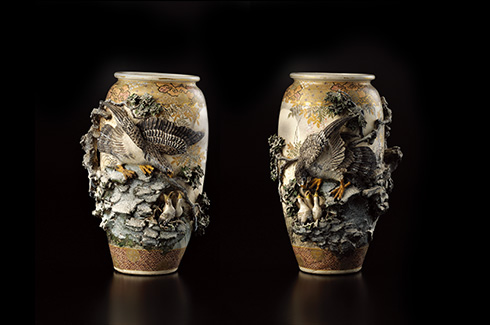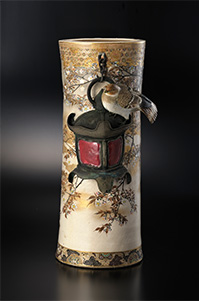


 概要
概要宮川香山展 ― 驚異の明治陶芸
横浜・眞葛ミュージアムコレクションから
【会期】2016年9月10日(土)~12月25日(日)
【開館時間】午前10時~午後4時
【休館日】火曜日 ※ただし火曜日が祝日の場合は開館
【入館料】一般700円(税込)※徳川将軍家墓所拝観共通券1,000円
Astonishing Meiji Ceramics! The works of Miyagawa Kôzan
from the Makuzu ware Museum Collection
September 10 (Sat.) — December 25 (Sun.), 2016
Hours: 10am — 5pm / Closed Tuesdays
Admission: ¥700 ※Combined visit to the Tokugawa family gravesite: ¥1000
宮川香山(初代)は、幕末の天保13年(1842)、京都・真葛ヶ原(現在の円山公園付近)の代々陶業を生業とする家に生まれました。幼少時より書画を学び、作陶にも頭角を表していましたが、父と兄が相次いで死去したことから、19歳の若さで家業を継ぐことになりました。そして明治維新の直後、新天地である横浜への移住を決意します。明治4年(1871)、太田村(現在の横浜市南区)に眞葛窯を開き、明治政府が外貨獲得のため奨励した殖産興業政策による輸出用の陶磁器制作を始めます。
香山が考案した、花瓶や香炉などの器面に写実的で過剰ともいえる動植物の装飾彫刻を施した「高浮彫(たかうきぼり)」作品は、明治9年(1876)のフィラデルフィア万博をはじめとする各国の博覧会で受賞を重ね、その独創的な表現で「眞葛焼(マクズウェア)」の名を世界にとどろかせました。その後、欧米における流行の変化を敏感に察知した香山は中国清朝の磁器を研究し、新しい釉薬や素地を開発することで、それまでの陶器から磁器制作へと眞葛焼の主力製品を転換していきました。また国内でも帝室技芸員に選ばれるなど、陶芸の発展や後進の指導に貢献したことでも知られています。
本展は、横浜に「宮川香山 眞葛ミュージアム」を設立された実業家の山本博士氏のコレクションによって構成されます。その多くは、地元から生まれ世界を魅了した幻のやきものである眞葛焼を、近年主に海外から里帰りさせた作品です。
今年は香山が没してから100年にあたります。「やきもの」という範疇を超え、その洗練された美的感覚と類まれなる超絶技巧を駆使した「高浮彫」と「釉下(ゆうか)彩(さい)」を中心に約40点の作品を展覧致します。

Miyagawa Kôzan (the first) was born in 1842 into a family that had made its livelihood from ceramics for several generations in Makuzugahara, Kyoto (now the area around Maruyama Park). At a young age, Kôzan studied painting and calligraphy and also made a name for himself at pottery. After the death of his father and older brother, at the age of 19, he took over management of the family business. Soon after the Meiji Restoration in 1868, he decided to move to the burgeoning city of Yokohama. In 1871, he opened the Makuzu kiln in Ota Village (now the Minami district of Yokohama) and began producing ceramics for export, encouraged by a new industrial policy of the Meiji government, the purpose of which was the acquisition of foreign currency.
The takaukibori (high relief) ceramic conceived by Kôzan in which the surface of vases, incense burners and other things was extravagantly sculpted with realistic depictions of animals and plants won awards at expositions in many countries, including the Philadelphia Exposition of 1876 and the name Makuzu-ware became known throughout the world for its creativity. Thereafter, Kôzan, who was alert to what was in and out of vogue in the West, began studying the Qing Dynasty ceramics of China, developed new glazes and bases, and then abandoned earthenware, making porcelain the main Makuzu product. In Japan also, he was appointed as Teishitsu Gigeiin, an artist of the Imperial Household, and became known as someone who contributed greatly to the development and advancement of ceramic art.
This exhibition features the fanciful Makuzu-ware that captivated the world, brought back to Japan from overseas, mainly in recent years, by businessman Yamamoto Hiroshi, founder of the Makuzu ware Museum in Yokohama, who hails from the place they originated.
This year marks 100 years since the death of Kôzan. Approximately 40 pieces will be exhibited, mainly his “high relief” and “underglazed” pieces which, with their refined sense of beauty and exceptional craftsmanship, transcend the parameters of mere pottery.




